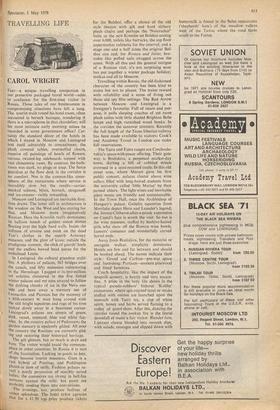TRAVELLING LIFE CAROL WRIGHT
Fear—a unique travelling companion in our protective packaged travel world—adds to confusion for the first-time visitor to Russia. Those tales of our businessmen in compromising situations have left a tang. The tourist trails round his hotel room, often accoutred in berserk baroque, wondering if there is a microphone in that chandelier; will his most intimate early morning noises be recorded in some government office? Cer- tainly the standard ddcor of the hotels in which I stayed in Moscow and Leningrad lent itself admirably to concealment; the Plush covered tables, overstuffed chairs, massive oil paintings of bowls of flowers, curious twisted-leg sideboards topped with vast chinoiserie vases. By contrast, the bath- room was stark, no plugs or soap. The fierce guardian at the floor desk in the corridor is no comfort. Nor is the canteen-like atmo- sphere of the restaurants where service is incredibly slow but the results—caviar, smoked salmon, blinis, bortsch, stroganoff and ice-creams—richly rewarding.
Moscow and Leningrad are inevitable first- time draws. The latter still in architecture is the window on the West and less stirring for that, and Moscow more imaginatively Russian. Here the Kremlin really dominates; its balloon bunch of golden onion domes floating over the high, hard walls. Inside the softness of ermine and mink on the dead Tsar's clothes in the superb Armoury museum, and the glow of icons; outside the prodigious cannon, the click of guards' heels and the endless bowed head queue for the embalmed I.enin.
In Leningrad. the cultural grandeur stulti- fies. A plethora of palaces. 365 bridges over the canals, and fifty museums culminating in the Hermitage, I gagged at its two million art exhibits cloistered in the five linked winter palaces and my eyes strayed to follow the drifting chunks of ice in the Neva out- side and bore away a memory not of Leonardos and Picassos but the mummy of a fifth-century BC man hung around with the still bright tapestries and rugs of his time tucked dimly away in a basement corner. Leningrad's palaces are streets of green, Pink, russet, mustard, blue and white fac- ades. In the country palace of Pedroverts the garden statuary is opulently gilded. All over the country the Russians are currently gild- ing and restoring their historical heritage. The gilt glistens, but so much is drab and bare. The visitor would avoid the common- Place in other countries. In Russia it is part of the fascination. Lacking in, goods to buy, shops become tourist museums. Gum is a vast hybrid of Pontings and Paddington glazed-in tiers of stalls. Fashion palaces re- veal a portly procession of sensibly suited ladies; the comm&res are strong in hell-fire sermons against the mini; hot pants are Probably sending them into convulsions.
The evenings, too, produce feelings of stolen splendour. The hotel ticket agencies that for a £1 .50 top price produce tickets
for the Bolshoi, offer a choice of the old style theatre with gilt and hard slithery plush chairs and perhaps the 'Nutcracker' Suite or the new Kremlin set Bolshoi seating over 6,000, toilets like barracks, the top floor supermarket cafeteria for the interval, and a stage one and a half times the original Bol- shoi size and, for Romeo and Juliet, bro- cades like puffed sails swagged across the scene. With all this and the general intrigue of a Russian visit, it's not surprising BOAC has put together a winter package holiday; troikas and all to Moscow.
Travelling within Russia, the old-fashioned character of the country has been kind to trains but not to planes. The trains reward with reliability and a sense of living out those old spy film settings. The Red Arrow between Moscow and Leningrad is a foreigner's favourite. Full of steam and pur- pose, it pulls sleeping coaches of yet more plush tables with little shaded Brighton Belle lamps and high varnished wood bunks. In the corridor the samovar simmers. Recently the full length of the Trans-Siberian railway has been made available to visitors; Cook's and Academy Travel in London can make full reservations.
The Tatra and Fatra ranges are Czechoslo- vakia's space-with-peace offering. Their gate- way is Bratislava, a perpetual market-day town, skirting a hill of cobbled streets crowned in a semi-restored castle. In this old street area, where Mozart gave his first public concert, palaces cluster above wine cellars filled with long-haired students from the university called 'little Marias' by their pained elders. The light wines and inevitable gipsy music are friendly and unmemorable. In the Town Hall, once the Archbishop of Hungary's palace, Gobelin tapestries from Mortlake depict Hero and Leander's legend; the Jimmy-Clitheroe-after-a-prank expression on Cupid's face is worth the visit. So too is the wine museum, staffed by beehive-haired girls who show off the Roman wine bowls, farmers' costumes .and wonderfully carved barrel ends.
Away from Bratislava, for the motorist or energetic walker, simplicity dominates. Hotels are few and far between and should be booked ahead. The names indicate their style : Grand and Carlton—pre-war space and furnishing; Partisan—modern pinewood and fitted furniture.
Czech hospitality, like the impact of the unspoilt scenery, is hearty and very mascu- line. A pride in the lusty life shows in the typical pseudo-robbers' hideout `Koliba' restaurants where spit-roasted trout or steaks stuffed with onions are launched upon the stomach with Tatry tea, a slap of white spirit, honey and herbs served flaming to a volley of pistol shots. After this, dancing the czardas round the sunken fire is the literal downfall of many a fair visitor. Blander fare, Liptauer cheese blended into smooth dips, with salads, sausages and slipped down with
buttermilk is found in the Saks restaurants ('shepherds' huts') of the meadow valleys west of the Tatras where the road turns south to the Fatras.


































 Previous page
Previous page